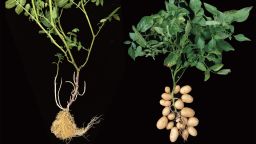Science
Wild Tomatoes in Galápagos Challenge Evolutionary Concepts

Hundreds of miles off the coast of Ecuador, a wild tomato species found in the Galápagos Islands is prompting scientists to rethink evolutionary principles. The plant, known as Solanum pennellii, was first studied in 2024 during a project focused on plant alkaloids, which serve as natural pesticides. Researchers observed an unexpected phenomenon: tomatoes from the younger western islands of the archipelago were producing alkaloids that had not been present in tomato plants for millions of years.
The team compared these younger tomatoes with samples from the older eastern islands. They discovered that the eastern plants had developed modern defense mechanisms, suggesting that the western varieties did not simply lag in their evolutionary trajectory. Instead, they appeared to exhibit signs of what some are calling “reverse evolution.”
“It’s not very common to see reverse evolution,” stated Adam Jozwiak, a molecular biochemist at the University of California, Riverside. The findings were reported in the journal Nature Communications in June. “We think that maybe environmental conditions put the pressure on these tomatoes to revert back to original or to ancestral state,” he added.
The physical characteristics of the western tomatoes differed slightly from their eastern counterparts. They exhibited a purplish hue and darker vines, while the most significant differences were molecular. Analysis of over 30 tomato samples revealed that the western Solanum pennellii possessed a molecular fingerprint reminiscent of eggplants, another member of the nightshade family. While modern tomatoes have lost the ability to produce eggplant alkaloids, those on the younger islands seem to have reverted to this ancestral trait.
Understanding these molecular changes could have far-reaching implications. Jozwiak noted that insights gained from studying these tomatoes might lead to the development of more resilient crops, enhanced pesticides, or even new medicinal compounds. This research could also provide a deeper understanding of evolutionary processes across various species.
Ancient Origins and Environmental Pressures
The tomato species likely arrived in the Galápagos Islands via birds carrying seeds approximately 1 to 2 million years ago. This migration occurred before the formation of the younger islands, resulting from volcanic activity. Jozwiak estimates that the evolution of the tomatoes on these islands happened within the last half million years, coinciding with the emergence of the youngest landmasses.
The environmental conditions on the eastern islands are markedly different from those on the western islands. The eastern islands feature a stable and biologically diverse environment, whereas the western islands present a harsher, less developed landscape. The toxic alkaloids produced by the western tomatoes not only help deter herbivores but may also assist the plants in nutrient absorption and disease resistance.
Jozwiak’s team identified minor changes in amino acid composition that triggered the reversion to ancestral traits. They even conducted experiments with genetically modified tobacco plants to replicate the production of these ancient compounds, confirming the mechanism behind this transformation.
Further research is necessary to clarify the benefits of these changes and the reasons behind this evolutionary reversal. The case of Solanum pennellii illuminates how plants adapt chemically to different environmental pressures, according to Anurag Agrawal, an evolutionary ecologist at Cornell University. He noted that the concept of reverse evolution is not surprising to many evolutionary biologists.
Challenging Established Theories
The idea of species developing island-specific traits is not new; Darwin famously documented such occurrences during his visit to the Galápagos in 1835, observing variations in finch beak shapes. Yet, the term “reverse evolution” remains contentious in evolutionary biology. Jozwiak cautioned that evolution is not typically viewed as a linear process.
Professor Eric Haag from the University of Maryland, who did not participate in the study, referenced Dollo’s Law, which posits that once a trait is lost, it cannot be regained in the exact form. He stated, “It appears the specific amino acid changes in the Galápagos species are some of the same ones found in much more distant ancestors.” This finding could pose challenges to traditional interpretations of evolutionary law.
While the tomatoes have regained some ancestral genes, they also exhibit modern traits, producing both ancient and contemporary alkaloids. Further investigation is essential to discern whether natural selection favored these ancestral mutations.
Although Jozwiak does not study human evolution, he mentioned that understanding the flexibility of evolutionary processes could lead to insights regarding other species. This might also open discussions about whether humans could experience a form of “reverse evolution,” reinstating ancestral genes over time. This concept echoes rare instances of humans born with rudimentary tails, a trait seen in primate ancestors over 25 million years ago.
Brian Hall, a research professor emeritus in evolutionary cell biology at Dalhousie University, referred to the term reverse evolution as “non-sensical,” arguing it implies a return to an ancestral state, which is impossible. Instead, he suggested it reflects a “retention of evolutionary potential,” much like horses that occasionally exhibit three toes, a trait lost in modern horses.
Conversely, Beth Shapiro, a professor of ecology and evolutionary biology at University of California, Santa Cruz, found the term useful for engaging the public in discussions about evolution. She noted, “Evolution isn’t directional; it’s random,” emphasizing that gene variants can resurface over time.
While opinions on the flexibility of evolution vary, Jozwiak concluded that it is essential to continue exploring how environmental conditions can shape the traits of various species. “It would be nice to show that the traits that species had in the past were perfect for that situation in the past, and if these conditions change now, we can go back to that trait that we had, or other species had,” he remarked.
This ongoing research into the wild tomatoes of the Galápagos Islands not only challenges established notions of evolution but also opens the door to new possibilities in understanding how species adapt and survive in changing environments.
-

 Sports2 weeks ago
Sports2 weeks agoSteve Kerr Supports Jonathan Kuminga After Ejection in Preseason Game
-

 Politics2 weeks ago
Politics2 weeks agoDallin H. Oaks Assumes Leadership of Latter-day Saints Church
-

 Business2 weeks ago
Business2 weeks agoTyler Technologies Set to Reveal Q3 2025 Earnings on October 22
-

 Science2 weeks ago
Science2 weeks agoChicago’s Viral ‘Rat Hole’ Likely Created by Squirrel, Study Reveals
-

 Lifestyle2 weeks ago
Lifestyle2 weeks agoKelsea Ballerini Launches ‘Burn the Baggage’ Candle with Ranger Station
-

 Lifestyle2 weeks ago
Lifestyle2 weeks agoDua Lipa Celebrates Passing GCSE Spanish During World Tour
-

 Entertainment2 weeks ago
Entertainment2 weeks agoZoe Saldana Advocates for James Cameron’s Avatar Documentary
-

 Health2 weeks ago
Health2 weeks agoRichard Feldman Urges Ban on Menthol in Cigarettes and Vapes
-

 Health2 weeks ago
Health2 weeks agoCommunity Unites for Seventh Annual Mental Health Awareness Walk
-

 World2 weeks ago
World2 weeks agoD’Angelo, Iconic R&B Singer, Dies at 51 After Cancer Battle
-

 Business2 weeks ago
Business2 weeks agoMLB Qualifying Offer Jumps to $22.02 Million for 2024
-

 Sports2 weeks ago
Sports2 weeks agoPatriots Dominate Picks as Raiders Fall in Season Opener









